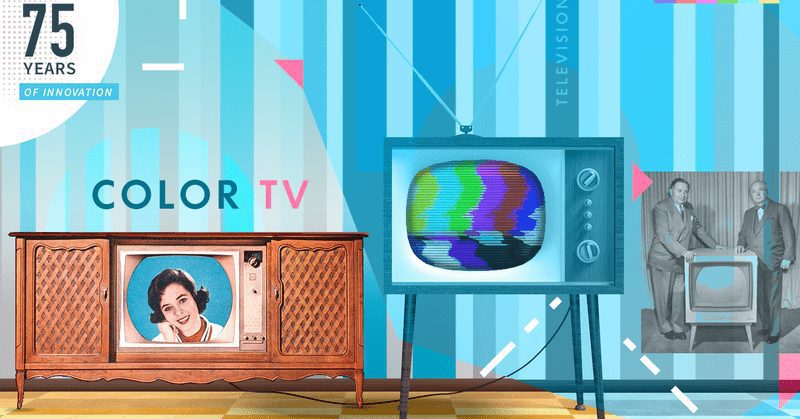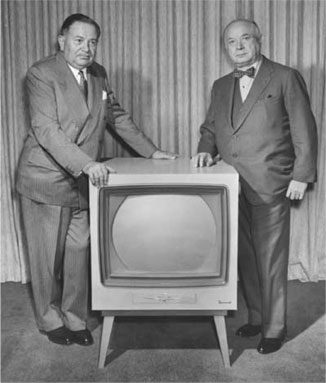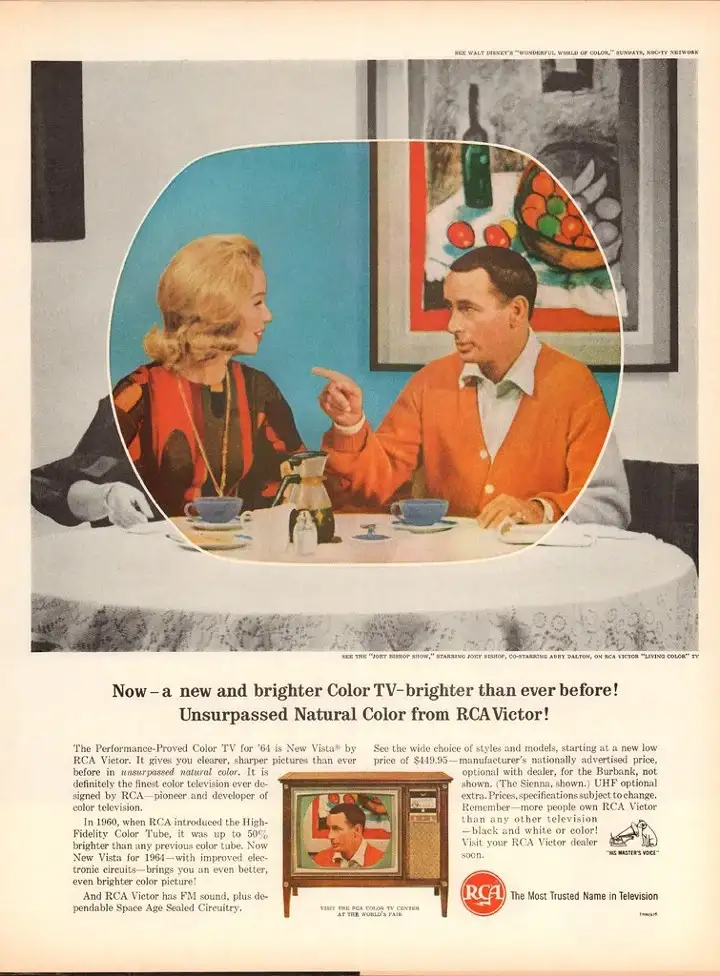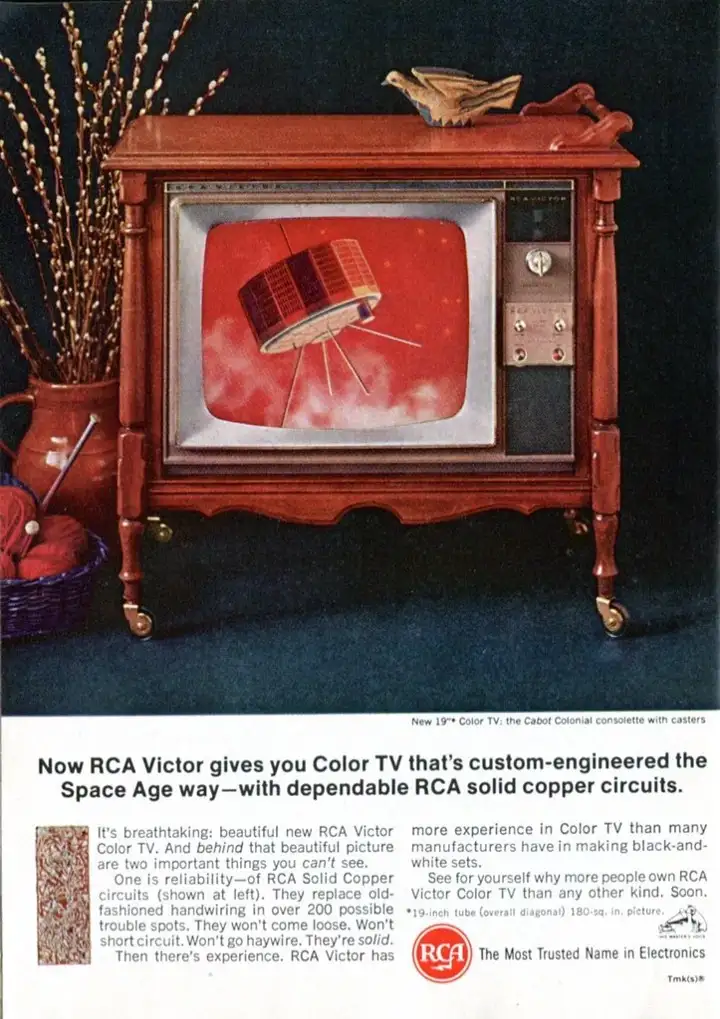The second NTSC standard, chosen in 1953, was still used until 2000 — chosen for its compatibility with existing B&W sets
The 75 Years of Innovation series highlights the groundbreaking innovations spanning from SRI’s founding in 1946 to today. Each week, SRI will release an innovation, leading up to its 75th anniversary in November 2021.

Over the rainbow: How SRI International brought color into our lives
[Color TV] adds a new dimension to the entertainment arts, adds realism to journalism, and intensifies television as a social and educational medium” — General David Sarnoff, Chairman of RCA Laboratories, on the release of RCA’s color television system in 1953.

SRI International and RCA Laboratories (now part of SRI International) have a long history of bringing innovation to a TV set near you. This history began when RCA brought a rainbow into our lives in the form of color television.
A parallel universe in black, white and color
Television is such an integral part of our lives that we often take it for granted. But the humble TV, currently in around 1.7 billion homes worldwide, has gone through many evolutionary phases, continuing to this day. SRI International has been part of the amazing journey of TV.
RCA Laboratories is well-known for some of the most critical inventions in broadcast TV, like the solid-state CCD camera that allowed for the development of TV as we know it today. But they weren’t the first to make color TV possible. However, like many innovations from the portfolio of SRI and its associated companies, they took an idea and made it work in the real world.
In the early 1940s, we see the first attempts at color TV. CBS Labs created a color television system based on a mechanical spinning disk. This system, however, had significant limitations that led to its abandonment — its resolution was poor, the images flickered and it was not compatible with existing black and white TVs. In 1953, there were already 28 million black and white sets in U.S. homes, and it was important not to suddenly make these sets obsolete. Balancing innovation with backward compatibility is one of the greatest challenges when developing new consumer technology. RCA successfully developed such a system, which became the de facto industry standard.

On December 17, 1953, the Federal Communications Commission (FCC) approved RCA’s Dot Sequential Color System, and RCA began the first commercial broadcast of a color image on a television screen. Again, one of the most important aspects of this new system was that it allowed color broadcasts to be received on existing black and white TVs. Although, of course, these images were still seen as black and white on those sets. This compatibility was essential for user acceptance and provided a smooth transition to color TV. It also provided a transition period, allowing broadcasters time to build up color capability gradually; NBC, for example, was transmitting only two color broadcasts per week. Allowing black and white TV to continue side-by-side with the development of color TV was vital in the transition to fully color-capable TV.
In 1953, industry analysts did not expect a mass market for color TV until 1956. But the color television set quickly entered living rooms throughout the US. The first dedicated television set compatible with RCA’s NTSC standard, the RCA CT-100, was sold beginning in 1954. The original cost was $1000, but this dropped to $495 soon after.
Compatible color: From black, white and grey to a rainbow of colors
One reason the CBS system failed was that it took a mechanical approach, based on a fast-spinning wheel containing red, green and blue colors. RCA’s system was all electronic — or solid-state — and was sturdier and more reliable because it did not rely on moving parts. The biggest reason for CBS’s failure, however, was the lack of compatibility with existing televisions.

RCA changed this by creating an all-electronic system dubbed “compatible color” in the early ads for the system. RCA’s color system receivers had to marry the existing standards used by black and white TVs with the additional requirements for transmitting images using the color spectrum. They had to take the existing standard TV signal and add the color information to it. They accomplished this by using a new type of picture tube with a repeating pattern of red, green and blue phosphor dots in front of a shadow mask, working with three separate electron guns in the tube. This allowed the simultaneous presentation of a red, green and blue image in one device. The human visual perception system combined these three images into one composite image with the full color spectrum. The colorful future of TV was set.
By developing a practical system for broadcasting and receiving color transmissions that could also be viewed on existing black and white TVs, RCA Laboratories (acquired by SRI International) laid the groundwork for mass adoption of this innovative technology. The rest, as they say, is history in full technicolor. The rest, as they say, is history in full technicolor.
Resources
SRI International, The Dish, CCD Broadcast Camera: https://medium.com/dish/75-years-of-innovation-ccd-broadcast-camera-61b0920c80db
YouTube, 1953 Compatible Color TV Announcement: https://youtu.be/ojJCJIaDp9Q
RCA CT-100: https://www.earlytelevision.org/rca_ct-100.html
RCA color compatible television fact sheet: https://www.earlytelevision.org/pdf/rca_compatible_color.pdf
Original RCA patent for Color TV system: https://pdfpiw.uspto.gov/.piw?docid=02594567
New York Times, 1969: https://www.nytimes.com/1969/01/06/archives/color-tv-outsells-black-and-white-for-first-time-and-tapes-coming.html


